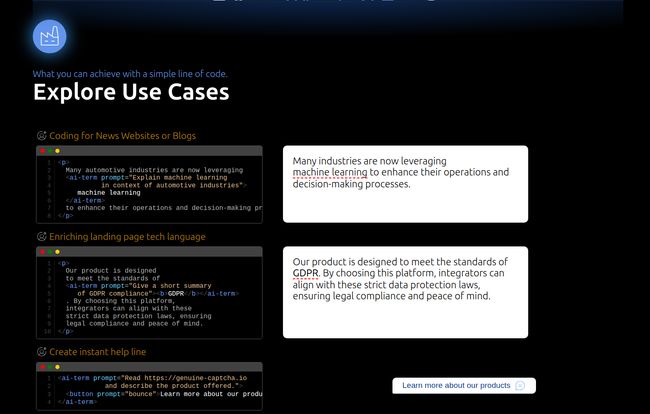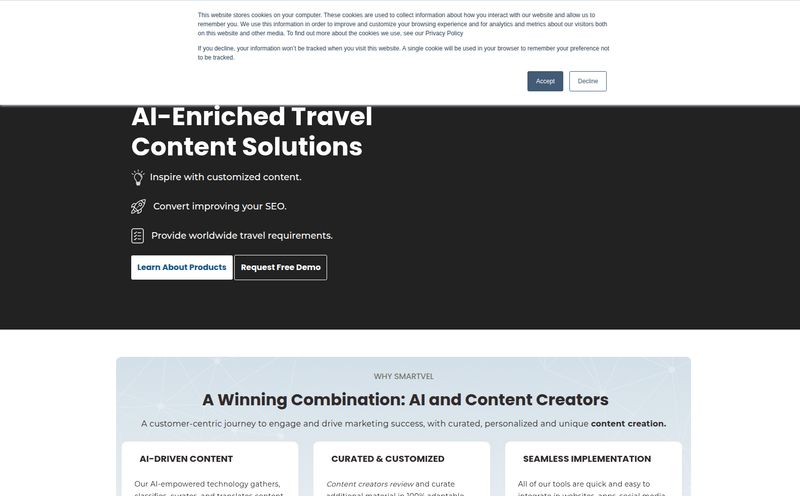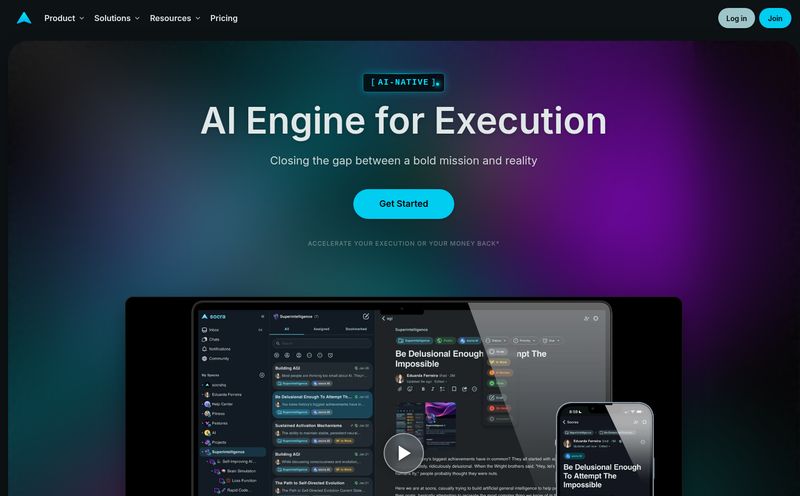We’ve all done it. You land on a promising article, maybe about a new marketing technique or a piece of software. You’re three paragraphs in, nodding along, and then… BAM. You hit a wall of jargon. A term so specific, so technical, you’d need a PhD and a secret handshake to understand it.
What do you do? If you’re like most people, you open a new tab, google the term, fall down a rabbit hole of explanations, and completely forget about the original article. That website owner just lost a reader. That’s a bounce. A lost conversion. A failure to connect. It’s a problem I call explanatory friction, and it’s a silent killer of traffic and engagement.
For years, the solution was clunky. Either we’d over-explain every term and bloat our articles, or we’d link out to a glossary and risk losing the reader forever. But what if there was a third way? What if you could provide crisp, AI-powered explanations right there, inside the text, without disrupting the flow? That’s the promise of a tool I’ve been playing with recently: AI-Term. And I have some thoughts.
What Exactly is AI-Term? (And Why It’s Not Another Chatbot)
First off, let’s clear the air. When you hear “AI for your website,” you probably picture one of those little chat bubbles in the corner, waiting to ask “Can I help you?” That’s not what AI-Term is. Not even close.
Think of it less like a chatbot and more like a tiny, on-demand expert living inside your words. It’s a UI component that you wrap around any complex word or phrase in your content. When a reader hovers over or clicks on that term, a small, clean overlay appears with a concise, AI-generated explanation. The user gets their answer and continues reading. No new tabs, no jarring pop-ups, no lost readers.
The integration is shockingly simple. For anyone who’s ever touched HTML, it looks something like this:
<p>Our company uses <ai-term prompt="Explain this simply">blockchain technology</ai-term> to secure transactions.</p>That’s it. You write your content, tag the tricky terms, and the tool handles the rest. It feels like a subtle superpower for your website, one that anticipates your reader's confusion and solves it before it becomes a problem.

Visit AI-Term
The Features That Actually Matter for SEO and UX
A tool can have a million features, but as an SEO, I only care about the ones that move the needle on traffic and user experience. AI-Term has a few that really caught my eye, because they seem to be built by people who actually understand the challenges of running a website.
Pre-Validated AI Responses: Your Safety Net
My biggest fear with any on-site AI is that it will go rogue. We've all seen the screenshots of AI getting things hilariously, or dangerously, wrong. This is where AI-Term gets clever. It allows you to pre-validate the AI’s responses. This means you can check, edit, and approve the explanation before it ever goes live. You get the speed and efficiency of AI without sacrificing control or accuracy. For anyone in a highly regulated or technical field like finance or healthcare, this isn't a bonus feature; it's a necessity.
The Power of Custom Prompts
This is where the magic happens. You’re not just getting a generic dictionary definition. Within the `ai-term` tag, you can give the AI a specific prompt. Want it to explain “machine learning” to a 5th grader? You can do that. Need to explain “GDPR compliance” to a CTO? You can do that, too. This level of control means the explanations can match your brand’s voice and your audience’s expertise level perfectly. It’s the difference between a tool and a true communication partner.
Non-Obtrusive Design and SEO Friendliness
I’m obsessed with site speed and Core Web Vitals. The last thing I want is a fancy widget that tanks my performance. The creators of AI-Term seem to get this. The tool is designed to be lightweight and non-obtrusive. It doesn't clutter the page or bog down loading times (the pricing tiers even boast about their cache speeds). From an SEO perspective, anything that keeps a user on your page longer (increasing dwell time) without hurting technical performance is a massive win. It’s a positive signal to Google that your page is valuable and user-friendly.
My Experience: The Good, The Bad, and The "Hmm, Interesting"
Alright, so on paper it sounds great. But what’s it like in the wild? I kicked the tires on AI-Term for a bit, and here’s the unfiltered breakdown.
The Good Stuff is genuinely good. The ease of setup is no joke. If you can copy and paste, you can get this running. I immediately saw its potential for boosting time-on-page metrics. For any of my clients with international audiences, the multi-language support (on the Pro plan) is a game-changer. It’s not just translating a word; it’s providing a full explanation in the user’s native language. That’s a powerful way to build trust.
But, it’s not perfect. My main gripe is with the prompt word limits on the lower tiers. The free plan caps you at 5 words per prompt, and the standard at 20. This forces you to be incredibly economical with your words, which can be a challenge when you're trying to guide the AI on a complex topic. It’s workable, but you feel the constraint. Also, a funny little detail: when I was doing my research, their own pricing page URL returned a 502 error for a bit. A real-world imperfection that reminds you there are humans behind the curtain.
Let’s Talk Money: AI-Term Pricing Breakdown
Price is always a factor, right? AI-Term uses a tiered model that seems pretty reasonable for what it offers. Here’s how it stacks up.
| Tier | Price | Key Features |
|---|---|---|
| Free | $0 / forever | 20 unique prompts, 5-word prompt limit, 1k API requests/day. Good for a test drive. |
| Standard | $6.60 / month | 200 unique prompts, 20-word prompt limit, 10k requests/day, Dashboard, Custom Prompts. The sweet spot. |
| Pro | $18.90 / month | 500 enrichments, 30-word prompt limit, 100k requests/day, Multi-language, Analytics, Context-aware. For power users. |
Breaking it Down
- The Free Tier: Is It Actually Usable? Yes, absolutely. For a small personal blog or just to see if you like the feel of the tool, 20 prompts is enough to get started. You'll just have to be a poet with that 5-word prompt limit.
- The Standard Tier: The Sweet Spot for Most. In my opinion, this is where the value is. For less than the price of a couple of fancy coffees, you get a much higher prompt limit and the dashboard. Most professional bloggers, small businesses, and marketers will find everything they need here.
- The Pro Tier: For the Power Users. If you’re a large SaaS company, a news organization, or have a big international footprint, the Pro plan is for you. Features like using your own domain content as context for the AI, multi-language support, and the analytics dashboard are professional-grade tools.
Who Should Use AI-Term? (And Who Can Skip It)
This isn’t a one-size-fits-all solution. So, who is this built for?
You should seriously consider it if you are:
- A SaaS company whose landing page is filled with terms like “server-side rendering” or “asynchronous processing.”
- A financial or legal blog trying to make dense topics accessible without dumbing them down.
- A niche e-commerce store selling products with technical specifications.
- Any content creator who respects their audience’s time and wants to lower that dreaded explanatory friction.
You can probably skip it if:
- Your content is very straightforward, like a personal travel blog or a recipe site.
- You have zero budget and find teh free tier’s limits too restrictive for your needs.
- You’d rather have a full, conversational AI chat experience for your users.
Conclusion: A Simple Tool for a Common Problem
In an industry flooded with AI tools that promise to revolutionize everything, AI-Term is refreshingly simple. It’s not trying to be a digital brain. It’s a scalpel, not a sledgehammer. It identifies one of the most common and persistent problems in web content—reader confusion—and provides an elegant, focused solution.
By reducing friction and keeping users on the page, it directly addresses key metrics that every SEO and website owner cares about. It's a small change that can have a surprisingly big impact on user experience and, ultimately, your bottom line.
Is it perfect? No. But it's a clever, well-executed idea that's absolutely worth trying, especially with a free tier that lets you take it for a spin. It’s a step toward making the web a little less confusing, one term at a time.
Frequently Asked Questions
- What makes AI-Term different from a chatbot?
- AI-Term is an inline clarification tool, not a conversational agent. It provides specific, pre-approved explanations for designated terms within your text, whereas a chatbot offers a broad, open-ended conversational interface. Think of it as a smart tooltip rather than a customer service rep.
- How hard is it to integrate AI-Term?
- It's very straightforward. The company provides guides for plain HTML/JavaScript, React, and WordPress. For most users, it's as simple as adding a script to your site and wrapping terms in an `
` tag. No complex coding is required. - Is AI-Term good for my website's SEO?
- In my professional opinion, yes. While it doesn't add new keyword-rich content that crawlers see directly, it significantly improves user experience signals. By keeping users on your page longer (increasing dwell time) and reducing bounce rates, you send strong positive signals to search engines like Google that your content is valuable and engaging.
- Are the AI-generated explanations always accurate?
- AI can always make mistakes. That’s why AI-Term’s most important feature is the ability to pre-validate and edit any explanation before it goes live. You have the final say, ensuring all information presented on your site is 100% accurate and aligns with your standards.
- Does it support multiple languages?
- Yes, multi-language support is available on the Pro Tier. This allows you to provide explanations in various languages, making your content more accessible to a global audience.



